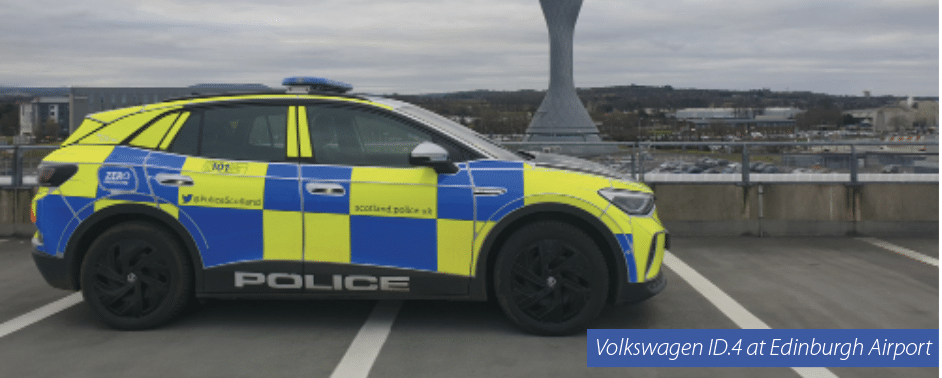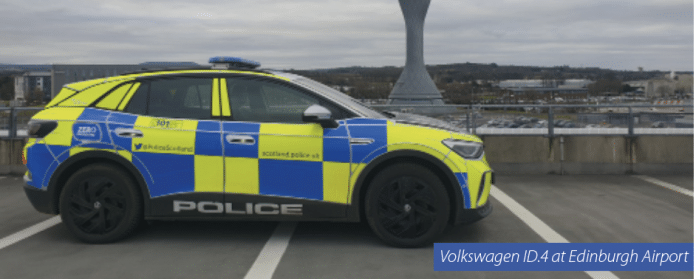Introduction
Fleets supporting essential services not only need to meet operational needs and day-to-day challenges of efficiency, safety, and compliance but also commit to strategies that aim for a low or zero-emission future. When these pressures apply to an emergency service, the challenges are even greater. In their fleet strategy published five years ago, Police Scotland stated that they were committed to becoming the UK’s first ultra-low emission emergency service fleet.
Essential Fleet Manager was eager to learn how Police Scotland had balanced the operational needs of an emergency service with the ambitions published in the fleet strategy. Therefore, we were delighted to sit down with Billy Andrew, who has over thirty-five years of experience in police vehicle and fleet management and is currently overseeing the transition to a low emission future.

Billy Andrew, EV Fleet Programme Manager, Police Scotland
Interview
Q: At the beginning of the process five years ago, what was the breakdown of Police Scotland’s fleet in terms of types of assets, numbers and fuel types?
Our total vehicle numbers were just under 3500, this was predominately diesel c. 95%. We operate a diverse fleet of marked and unmarked vehicles including motorcycles, LCVs, HGVs, pickups, 4x4s and cars.
Q: How did you approach engagement across all Police Scotland departments and relevant third parties to prepare the way for electrification?
Our 10-year Fleet Strategy published in 2019, laid out what we proposed to accomplish if we received the corporate and financial support to transition the fleet to 100% ULEV by 2030. Early engagement with all internal and external stakeholders was and has been paramount to our success to date.
Explaining and educating are key to winning over officers and staff. Our Force Executive was clear, that this had to be one area we focused on and we continue to do so.
Q: What were the main priorities identified immediately following that engagement and how did you decide which parts of the fleet could be transitioned to Electric Vehicles (EVs) in the short term?
In 2018, we installed 29 EV chargers across several of our offices. We realised that to achieve our 2030 goals, we would need chargers at approximately 200 additional offices. In 2020, we put out a tender and awarded a turn-key solution in late 2021. We divided the offices into three phases: Phase 1 with 50 sites, Phase 2 with 50 sites, and Phase 3 with 100 sites. We prioritised our largest offices in terms of vehicles and staff numbers. As Phase 1 progressed (now completed), we began replacing our unmarked cars. We found this to be straight forward because they could utilise public chargers as well as our ‘private network.’
Q: With global supply chain issues combined with volatile EV residual values, how did Police Scotland manage the procurement process, to ensure that strategic objectives could be met with financial efficiency?
After finalising our capital allowance for new vehicles, we proceeded to place orders with four different manufacturers for our electric vehicles. The lead times were reasonable. All our vehicles are purchased through national frameworks established by Blue Light Commercials and the National Association of Police Fleet Managers (NAPFM). Our primary focus has always been on Whole Life Costing (WLC), which takes into account projected residual values, although this is not considered a key factor in our decision-making.
Q: How is Police Scotland combining its charging infrastructure with the public charging network to meet the needs of EVs in all parts of Scotland?
I am currently in the process of contacting Charge Point Operators (CPOs) to integrate their charging networks. Each of our EVs comes with a single RFID card that allows access to multiple networks across the UK. Some of the networks we are working with include BP Chargevision/Pulse, Charge Place Scotland, Scottish Fire & Rescue, Scottish Ambulance, First Bus, FOR EV, and INEOS. We also have several co-location sites with the NHS and shared chargers. In total, these provide access to around 12,000+ chargers. I am constantly working to increase this number. This is an area that is undergoing considerable change. It’s likely that in the next 12 months, roaming will be introduced, making it easier to access additional networks.
Q: A shortage of automotive technicians is causing immense challenges for many fleet operators. How is Police Scotland addressing those challenges throughout its workshops and those of outsourced partners?
We recognised the need several years ago and decided to put all our Vehicle Technicians (c.60) through the IMI Level 3 courses on BEV and Hybrid electric. We monitor and pay competitive salaries on par with the manufacturer dealerships. We don’t have an issue with staff retention.
Q: Now that the first EV response vehicles are on the fleet, with more to follow in the next few months, what is the current breakdown of fleet assets?
Our total number of BEVs on the fleet is just over 800 vehicles with around another 250 ULEVs, mostly unmarked. After nearly 18 months of evaluation and testing, we are introducing our first 25 marked response cars. These are Volkswagen ID4s and this will be followed by a similar number of Vauxhall Vivaro cell vans. Our total fleet size still sits at just under 3500 vehicles.
Q: Overall, which priorities have informed your vehicle procurement choices?
It’s challenging to prioritise the purchase of police vehicles, especially electric ones, due to several important considerations: range, performance, weight capacity, safety, whole-life costing, and charge speeds, among others.
Q: With technology developing at pace, how difficult is it to make the right choices and, as far as possible, future-proof your fleet operations?
I’d like to break this down into at least two parts. The first part will focus on the EV charging hardware and the back-office functions for those. The second part will look at the products from vehicle manufacturers.
a) It’s important to read, absorb, and ask the right questions about new chargers from various manufacturing competitors to understand the direction the market is likely to take. Make sure that any chargers purchased have the latest market technology built in, allowing the newest software to be installed and updated remotely as new developments take place.
b) Vehicle manufacturers are continually developing new products to bring to the market, aiming to anticipate what the industry is looking for. As each manufacturer’s range increases and the markets mature, I do not doubt that the right vehicles will appear, allowing us to evaluate and eventually make a purchase.
Q: How has The Scottish Government provided valuable support for your fleet strategy and can they, along with the UK government do more?
If the UK Government is serious about trying to increase the number of people purchasing EVs that must rely on the public charger networks, I think removing the VAT content would go some way to balancing up the cost of EV ownership, against those that can charge at home.
Scottish Government (SG) has provided Police Scotland with additional monetary resources to allow us to start our phased EV infrastructure project. They also had the insight some 20 years ago to fund the Charge Place Scotland infrastructure. Governments can always do more, one of SG’s main focuses now is collaboration between many public bodies on sharing and building new EV charging infrastructure. Each Blue Light service in Scotland is committed to trying to make this happen.

This article was featured in Essential Fleet Manager Magazine issue 4(2024) – read the full issue below.




